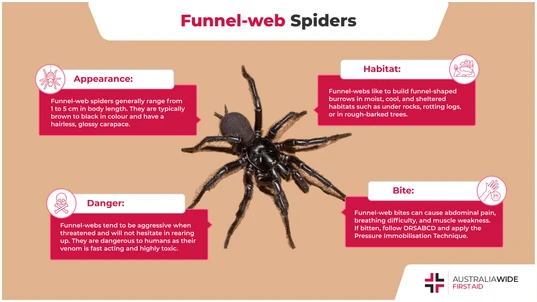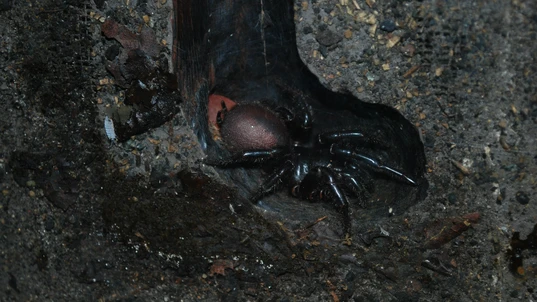The Funnel-web Spider: Australia's Most Dangerous Arachnid

Bites and Stings

Funnel-web spiders are commonly found along the eastern coast of Australia. They are one of the most dangerous spiders in the world, and have been attributed to numerous human fatalities. So how do you successfully treat a Funnel-web spider bite? Let's take a look.
More common in the states along the eastern coast of Australia, Funnel-Web Spiders are one of the deadliest spiders in the world due to their highly toxic and fast-acting venom and are one of the most feared arachnids in the animal kingdom.All About the Funnel-Web Spider
Funnel-web spiders can be found all over the world, however, there are three main spider families that are popularly known generally as ‘funnel-web spiders’:- Agelenidae,
- Hexathelidae, and
- Dipluridae.
Identifying a Funnel-Web Spider
Being able to identify a funnel-web spider might save your life someday and here are some quick pointers to identify if the spider you’re looking at is indeed the deadly funnel-web kind. Here are some identifiers that are typical of the funnel-web spider:- Medium or large body lengths ranging from 1 to 5 cm
- Shiny, hairless, and glossy carapace (upper shell covering the front part of their bodies)
- No obvious body pattern with typically black to brown body colour
- Eyes closely grouped together
- Four relatively long spinnerets (the silk-spinning organ of the spider)
- Fangs that point straight down the body
Funnel-Web Spiders and Their Hunting Habits
As featured in their name, funnel-web spiders hunt by waiting in their makeshift funnel for prey to fall onto the horizontal web before it rushes out, grabs the prey, and takes it back into the funnel to consume. They typically make their burrows in moist, cool, and sheltered habitats such as under rocks, rotting logs, or in rough-barked trees. While you don’t have to worry about these spiders dwelling in your lawn, they are commonly found in suburban rockeries and shrubberies hiding in the shadows. These spiders are mainly sedentary and spend their entire lives (female spiders can live up to 20 years!) inside the burrow – venturing into the outside world momentarily to lunge at any passing prey. Majority of their prey consists of insects and small vertebrates such as lizards and frogs.
Funnel-web spiders create funnel-like webs deep in the ground as their homes, rarely venturing out until mating season.
Are Funnel-Web Spiders Dangerous to Humans?
With a total of 13 recorded deaths as of writing, funnel-web spiders can be dangerous to humans due to the highly toxic and quick-acting venom in each bite. However, not all funnel-web spiders are dangerous neither are they specifically out to get us. Research has shown that the development of these highly toxic bites was developed as a defence against predators. Typically, when male funnel-web spiders are young, their venom is fatal to small insects which they eat. However, once these males begin their search for a female mate, they must leave the safety of their burrows and venture into the unknown. This is when their venom becomes potent enough to cause death in vertebrates such as reptiles, mammals, and even humans. On the bright side, funnel-web spiders are the most poisonous during the spiders’ summer mating season – when majority of male spiders begin to leave their burrows, needing defences to protect themselves against potential predators.What To Do If a Funnel-Web Spider Bites Me?
It’s crucial to act fast as the bite of this spider is fatal. Funnel-web spider bites are extremely painful with a noticeable red bump forming at the bite site. Other symptoms of a funnel-web spider bite include:- Nausea, vomiting, and abdominal pain,
- Difficulty in breathing, disorientation, confusion, unconsciousness,
- Heavy coughing,
- Profuse sweat, tears, and saliva production,
- Weakness or numbness in muscles and muscular twitching, and
- Small hairs standing on end.
First Aid for a Funnel-Web Spider Bite
Once bitten, it’s important for you to keep this guide in mind:- Keep the casualty at rest, reassured, and under observation.
- Call 000 or 112.
- Follow the basic life support guidelines per DRSABCD.
- Apply the Pressure Immobilisation Technique. The purpose of the pressure immobilisation technique is to prevent the venom from moving into circulation, thereby "buying" the patient time while they wait for medical treatment. Wrap a bandage over the bite site as tightly as you would a sprained ankle. Extend the bandage all the way up the limb, and then immobilise the limb. Note, the pressure immobilisation technique should only be used for Funnel-web spider bites and snake bites.
- Do not use a tourniquet.
- Do not cut, suck, or wash the bite site.
Spider Bites and Anaphylaxis
If the casualty begins exhibiting signs of a severe allergic reaction, otherwise known as anaphylaxis, call Triple Zero (000) for an ambulance, consult the Australian Resuscitation Council's anaphylaxis treatment guideline, and follow DRSABCD and be prepared to perform CPR.Conclusion
With spring just around the corner, it’s important to stay clear of these eight-legged creatures due to their toxic bites and the threat they pose to us. But if you do happen to stumble upon a funnel-web spider and unfortunately get bitten by one, it’s important to remember first aid procedure during emergencies. By applying these first aid techniques, you’ll be able to save a life in dire times. If you’re interested in learning the skills and knowledge to provide first aid response and life support, check out our First Aid Course that will allow you to manage casualties, incidents and other first aiders until qualified emergency help arrives at the scene.Recommended Resources
We also have articles on what to do if you get stung or bitten by a snake, fire ant, and different types of marine life. And for more details on how to identify and treat bites from some of Australia's deadliest spiders, including White tail spiders, Wolf spiders, Huntsman spiders, and Redback spiders, head to our Resource Library. Disclaimer: This article is for informational purposes only. It does not constitute, replace, or qualify as any form of first aid training.
Originally published at
https://www.australiawidefirstaid.com.au/resources/funnel-web-spider
as part of the Australia Wide First Aid Articles Library









